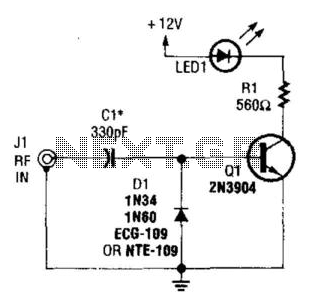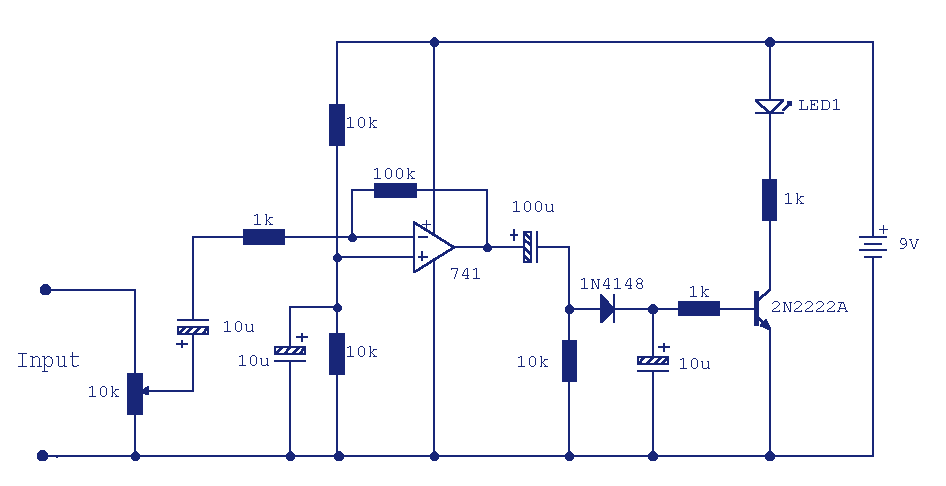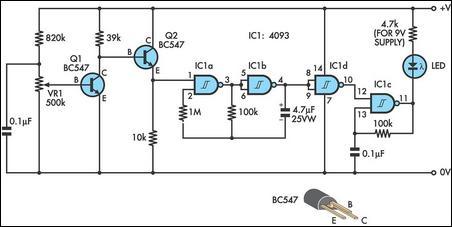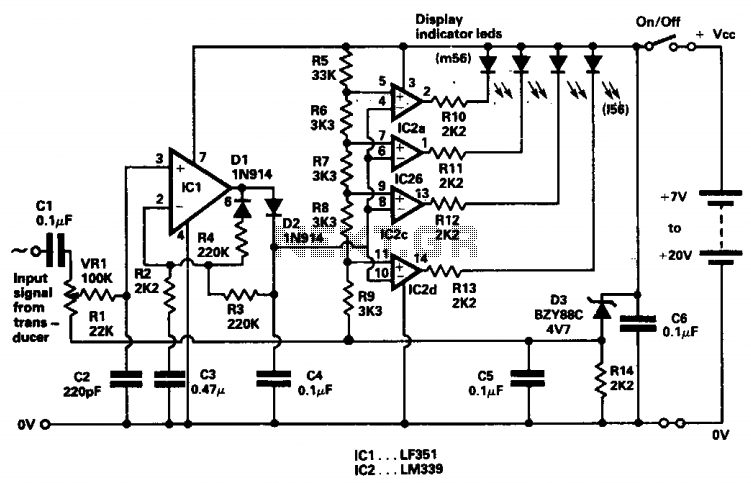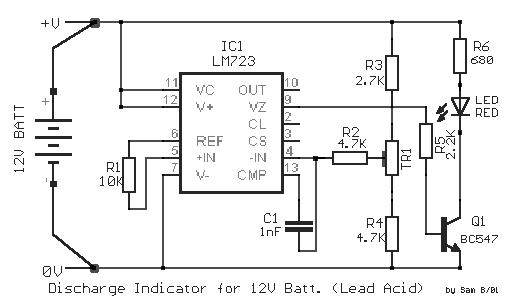
Voltage-Level Indicator
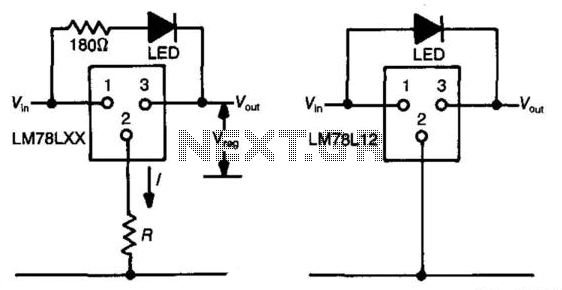
The three-terminal regulator device (LM78LXX) provides an output voltage (Vout) equal to the input voltage (Vm) until the input voltage exceeds the output voltage by 1.5 to 2 volts. A regulated voltage (Vreg) is achieved at this point, with a necessary differential of 1.5 V between the input and output to activate the LED. The LED illuminates when Vm exceeds the sum of Vreg, the current through the resistor (IR), and an additional 1.5 V, where the current is typically 6 mA (a zener diode can be used instead of the resistor). If the input voltage is significantly higher than required to power the LED, a current-limiting resistor in series may be needed. An example of a practical application in automotive systems is provided, indicating that when the battery voltage is above 13.5 V, it signals that the alternator/regulator/battery system is functioning correctly. When the engine is off, the battery voltage drops to 12 V, causing the LED to turn off. The circuit operates without the need for calibration.
The LM78LXX series of three-terminal linear voltage regulators are widely utilized in various electronic applications due to their simplicity and effectiveness in providing stable output voltages. The device operates by maintaining a constant output voltage (Vout) as long as the input voltage (Vm) remains within specified limits, specifically 1.5 to 2 volts above Vout. This characteristic makes the LM78LXX suitable for applications where voltage regulation is critical, such as in powering LEDs or other low-power devices.
In the context of LED operation, the circuit requires a minimum differential voltage of 1.5 V between the input and output to ensure proper illumination. The LED will turn on when the input voltage exceeds the combined value of the regulated voltage (Vreg), the voltage drop across the current-limiting resistor (IR), and an additional 1.5 V. The typical forward current for the LED is approximately 6 mA, which can be managed by using a resistor or a zener diode to limit the current, thus protecting the LED from excess current that could lead to failure.
In automotive applications, the circuit's ability to indicate battery voltage levels is particularly useful. When the battery voltage exceeds 13.5 V, the circuit signals that the alternator and regulator are functioning properly, providing a visual cue through the illuminated LED. Conversely, when the engine is turned off, the battery voltage drops to around 12 V, which results in the LED turning off, indicating that the system is not charging. This functionality is crucial for monitoring the health of the vehicle’s electrical system without requiring complex calibration or setup, making it an efficient solution for automotive diagnostics.
Overall, the LM78LXX voltage regulator circuit exemplifies a practical and straightforward approach to voltage regulation and monitoring, with applications extending beyond automotive systems to various electronic devices requiring stable voltage levels. Three-terminal regulator device (LM78LXX) has Vout = Vm until the input rises 1.5 to 2 V above the output when the regulated voltage Vreg = XX is obtained. A differential of 1.5 V between input and output is necessary to light the LED. Thus, the LED lights when Vm rises above Vreg + IR + 1.5 V, where lis typically 6 mA (a zener diode could be used in place of R). For input voltages much higher than necessary to light the LED, a current-limiting resistor in series might be necessary.
A useful automotive application is shown in Fig. 14-9(b). The circuit indicates when battery voltage is above 13.5 V which indicates (in conjunction with an ammeter) whether the alternator/regulator/battery system is operating correctly. With the engine off, the battery voltage drops to 12 V and the LED extinguishes. The circuit requires no calibration.
The LM78LXX series of three-terminal linear voltage regulators are widely utilized in various electronic applications due to their simplicity and effectiveness in providing stable output voltages. The device operates by maintaining a constant output voltage (Vout) as long as the input voltage (Vm) remains within specified limits, specifically 1.5 to 2 volts above Vout. This characteristic makes the LM78LXX suitable for applications where voltage regulation is critical, such as in powering LEDs or other low-power devices.
In the context of LED operation, the circuit requires a minimum differential voltage of 1.5 V between the input and output to ensure proper illumination. The LED will turn on when the input voltage exceeds the combined value of the regulated voltage (Vreg), the voltage drop across the current-limiting resistor (IR), and an additional 1.5 V. The typical forward current for the LED is approximately 6 mA, which can be managed by using a resistor or a zener diode to limit the current, thus protecting the LED from excess current that could lead to failure.
In automotive applications, the circuit's ability to indicate battery voltage levels is particularly useful. When the battery voltage exceeds 13.5 V, the circuit signals that the alternator and regulator are functioning properly, providing a visual cue through the illuminated LED. Conversely, when the engine is turned off, the battery voltage drops to around 12 V, which results in the LED turning off, indicating that the system is not charging. This functionality is crucial for monitoring the health of the vehicle’s electrical system without requiring complex calibration or setup, making it an efficient solution for automotive diagnostics.
Overall, the LM78LXX voltage regulator circuit exemplifies a practical and straightforward approach to voltage regulation and monitoring, with applications extending beyond automotive systems to various electronic devices requiring stable voltage levels. Three-terminal regulator device (LM78LXX) has Vout = Vm until the input rises 1.5 to 2 V above the output when the regulated voltage Vreg = XX is obtained. A differential of 1.5 V between input and output is necessary to light the LED. Thus, the LED lights when Vm rises above Vreg + IR + 1.5 V, where lis typically 6 mA (a zener diode could be used in place of R). For input voltages much higher than necessary to light the LED, a current-limiting resistor in series might be necessary.
A useful automotive application is shown in Fig. 14-9(b). The circuit indicates when battery voltage is above 13.5 V which indicates (in conjunction with an ammeter) whether the alternator/regulator/battery system is operating correctly. With the engine off, the battery voltage drops to 12 V and the LED extinguishes. The circuit requires no calibration.
